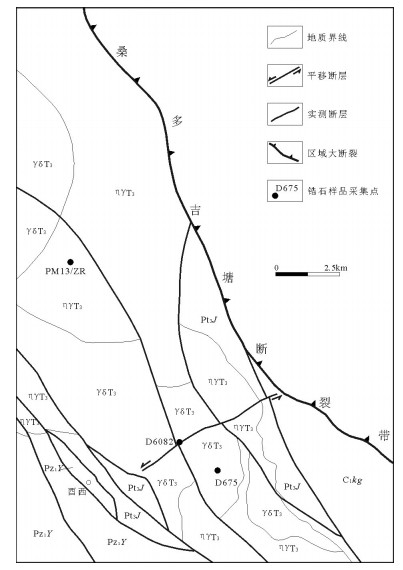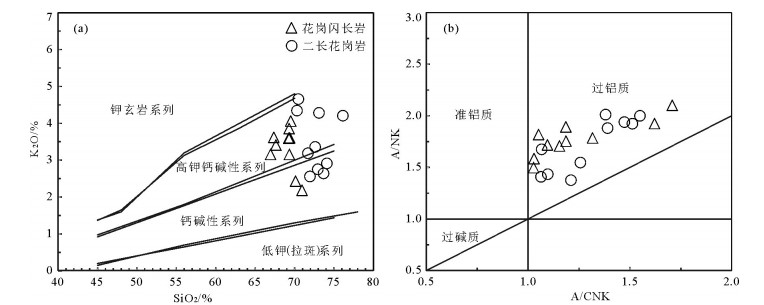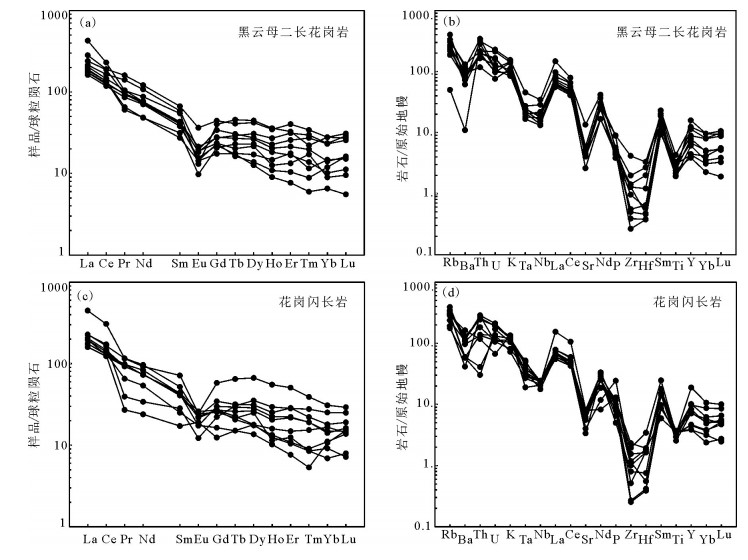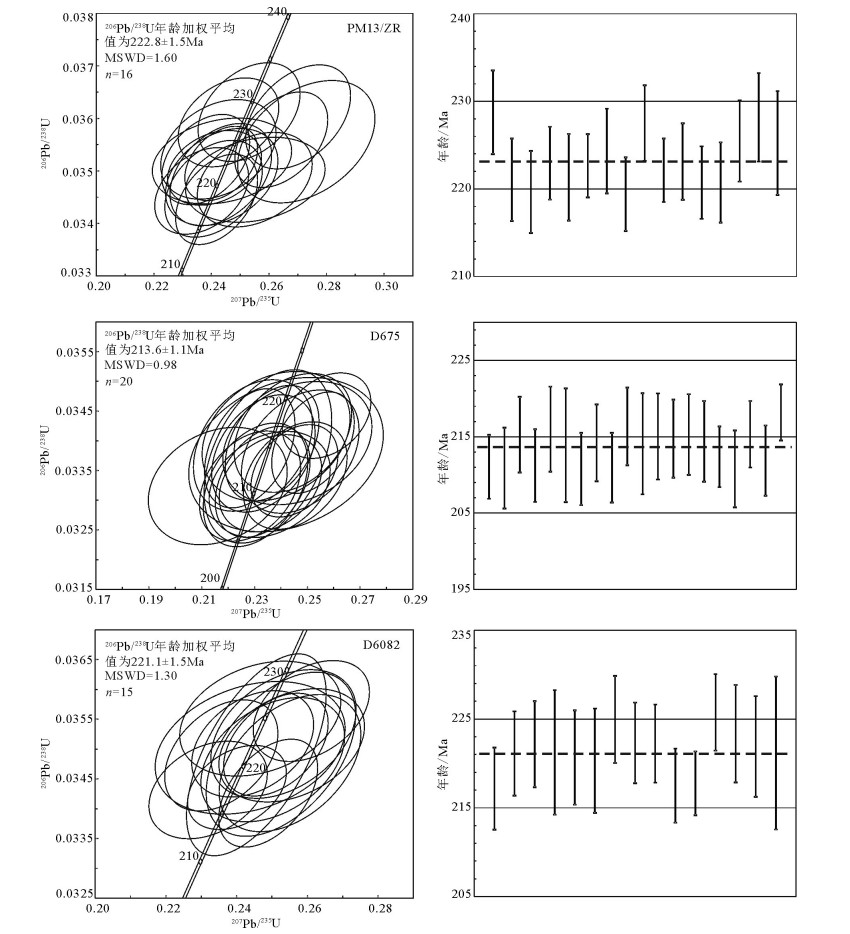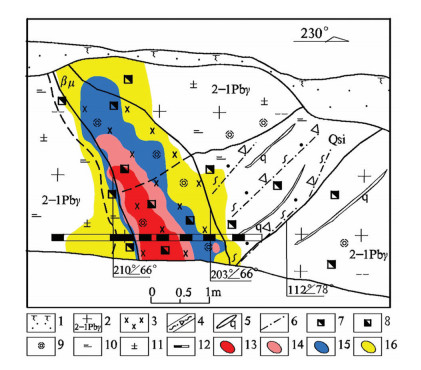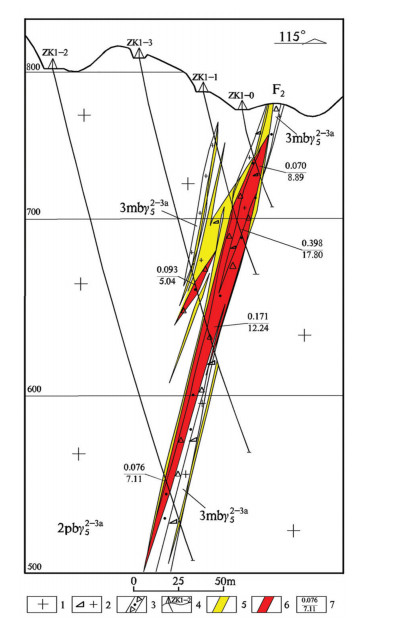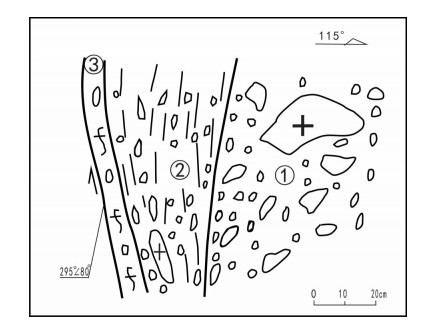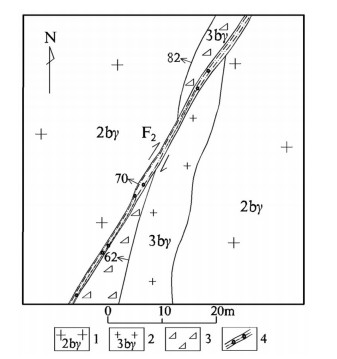The characteristics of ore-controlling fault and its relationship to uranium mineralization in Shangwei area, Southern Jiangxi Province
-
摘要:
位于江西省龙南县上围地区出露的燕山期花岗质复式岩体明显受北东向马屎山硅化断裂带和鹅形石英断裂夹持控制,是有利的产铀岩体,已探明291铀矿床和292矿点。岩体内断裂作用强烈,热液蚀变和铀矿化现象普遍。经地质调查,在岩体内识别出北东向断裂6条和北北东向断裂11条及若干北西-北西西向断裂。其中,北东向断裂主要包括岩体西部的硅化带和东部的石英断裂;北北东向断裂主要包括岩体东部的蚀变碎裂岩带和西部硅化破碎带;北西-北西西向断裂多被中基性岩脉充填,主要包括501~504号脉。北北东向断裂与铀成矿关系最密切,是容矿断裂。断裂的规模和产状控制了铀矿体的空间分布和展布形态,断裂性质控制了铀矿化类型,断裂变形程度控制铀矿化蚀变分带,断裂与中基性岩脉复合控制了富铀矿体的产出形态。
Abstract:Shangwei area is in southernmost Longnan County, Jiangxi Province. The Yanshanian Shangwei granite complex pluton is strictly controlled by NE-trending Mashishan fault zone and Exing fault and occurs in the NE-trending oval form. It is a uraniumbearing granite body, where there exist known uranium deposit No. 291 and No. 292 uranium ore spot. Due to strong faulting, alterations and mineralizations are abundant in main fault belts. Geological survey reveals that the fracture tectonic system in Shangwei area is mainly formed by 6 NE-trending faults, 11 NNE-trending faults and some NW-NWW trending faults. The NE-and NNEtrending faults include silicified fault (QF3, QF4), quartz fault (QF7~QF9), silicified fractured fault (QF1, QF2, QF5 and QF6) and altered cataclastic fault (F1, F2, F3 and F7). The NW-trending fault is usually filled with intermediate basic veins (501~504). NNE-trending faults are intimately related to uranium mineralization, and are thus the main ore-bearing faults. Uranium orebody occurs within the NNE-trending faults and bears a close relation to silicified breccia and cataclastic altered rock. The attitude of NNE-trending fault controls the dip of the orebody, its property controls the mineralization types, the deformation behaviour controls the horizontal zoning characteristics of mineralization and alternation, and the fault and the veins obviously control the shape of rich uranium orebody.
-
龙木错-双湖-澜沧江碰撞结合带的存在与否一直存在争议[1-4],李才[1]认为,龙木错-双湖-澜沧江结合带是南羌塘地块与北羌塘-昌都地块之间的一条重要的碰撞结合带,但对该结合带形成时代的认识有较大的差异[1, 4-7]。澜沧江岩浆岩带沿澜沧江结合带呈带状分布,如临沧花岗岩、东达山花岗岩、纽多花岗岩和吉塘复式花岗岩。研究区大地构造位置处于羌北-昌都地块、双湖-澜沧江结合带和羌塘左贡地块的交会部位(图 1-a),区域大地构造位置独特,构造演化复杂。吉塘复式花岗岩体分布于昌都芒康盆地与类乌齐-左贡陆缘山盆之间,南东角与俄让-竹卡岩浆弧相邻,为北澜沧江结合带的重要组成部分(图 1-b)。北澜沧江结合带出露新元古界吉塘岩群(Pt3J)、下古生界酉西群(Pz1Y)、下石炭统卡贡组(C1kg)和卡贡岩组(C1k),被中—晚三叠世中酸性岩浆岩破坏严重,吉塘岩群多以残留体形式出现,两侧以上三叠统—侏罗系碎屑岩为主。吉塘复式花岗岩具有弱糜棱岩化、碎裂岩化,研究其成因及年代学,有助于解秘澜沧江花岗岩带的形成时代,分析澜沧江结合带的闭合时限。基于此,本文在对出露于澜沧江岩浆岩带北段的吉塘复式花岗岩进行野外地质调查的基础上,开展了吉塘复式花岗岩中黑云母二长花岗岩和花岗闪长岩的全岩组成、锆石U-Pb年龄研究,进而分析吉塘复式花岗岩的形成时代,为进一步研究澜沧江岩浆岩带和澜沧江结合带提供重要依据。
![]() 图 1 图 1 研究区大地构造位置图(a)和区域地质简图(b)1—上三叠统-侏罗系碎屑岩;2—上三叠统碎屑岩;3—上三叠统竹卡组安山岩、岩屑凝灰岩;4—下石炭统卡贡组变质砂岩、千枚岩;5—下石炭统卡贡岩组变质砂岩、千枚岩夹大理岩、玄武岩岩块;6—下石炭统邦达岩组+错绒沟口岩组变质砂岩、千枚岩;7—下古生界酉西群;8—新元古界吉塘岩群;9—古-中元古界卡穷岩群;10—晚白垩世二长花岗岩、似斑状二长花岗岩;11—早侏罗世二长花岗岩、似斑状钾长花岗岩;12—晚三叠世花岗闪长岩;13—晚三叠世二长花岗岩;14—中三叠世二长花岗岩;15—中奥陶世二长花岗岩;16—晚寒武世石英闪长岩;17—区域次级断裂;18—区域分区断裂Figure 1. Tectonic location of study area (a) and regional geological sketch map (b)
图 1 图 1 研究区大地构造位置图(a)和区域地质简图(b)1—上三叠统-侏罗系碎屑岩;2—上三叠统碎屑岩;3—上三叠统竹卡组安山岩、岩屑凝灰岩;4—下石炭统卡贡组变质砂岩、千枚岩;5—下石炭统卡贡岩组变质砂岩、千枚岩夹大理岩、玄武岩岩块;6—下石炭统邦达岩组+错绒沟口岩组变质砂岩、千枚岩;7—下古生界酉西群;8—新元古界吉塘岩群;9—古-中元古界卡穷岩群;10—晚白垩世二长花岗岩、似斑状二长花岗岩;11—早侏罗世二长花岗岩、似斑状钾长花岗岩;12—晚三叠世花岗闪长岩;13—晚三叠世二长花岗岩;14—中三叠世二长花岗岩;15—中奥陶世二长花岗岩;16—晚寒武世石英闪长岩;17—区域次级断裂;18—区域分区断裂Figure 1. Tectonic location of study area (a) and regional geological sketch map (b)1. 岩相学特征
吉塘复式花岗岩位于藏东察雅县吉塘镇以西约3km处,总体呈北西—南东向展布,侵位于新元古界吉塘岩群(Pt3J)变质岩系中,长约70km,宽2~ 10km,出露面积约340km2,该岩体为一复式岩体[7-8],主要由黑云母二长花岗岩和花岗闪长岩组成,在岩体边部,由于受到区域构造活动的影响,局部见碎裂岩化和糜棱岩化(图 2)。
黑云母二长花岗岩:灰白色,具细-中粒半自形粒状结构,花岗结构,块状构造。矿物组成为石英(25% ~35%)、斜长石(30% ~40%)、碱性长石(20%~35%)、黑云母(10%~15%),以及少量锆石、榍石、绿泥石、磁铁矿、磷灰石等。斜长石呈无色,略浑浊,半自形长板状产出,粒径集中在2~5mm,次为0.5~2mm,发育聚片双晶,具明显的绢云母化。碱性长石呈半自形-他形板状,粒径多为2~ 4mm,次为0.5~2mm,具弱粘土化,发育条纹构造及格子状双晶。石英呈他形粒状,粒径0.3~ 2.2mm,少量为0.05~0.1mm,呈彼此镶嵌状分布于裂隙中。黑云母呈黄绿色,粒径0.5~2.5mm,多发育绿泥石或完全交代呈假象产出,偶见解理缝中未蚀变完全的棕色黑云母残余。锆石、榍石、磷灰石等呈自形柱状产出,总含量约2%。
花岗闪长岩:灰白色,具细-中粒半自形粒状结构,块状构造。主要由石英(20%~25%)、斜长石(35% ~45%)、碱性长石(10% ~20%)、黑云母(10%~15%),以及少量锆石、榍石、绿泥石、磷灰石等组成。斜长石为更-中长石,粒径0.5~2mm;碱性长石主要为条纹长石,并出溶密集而狭窄的钠长石条带;黑云母呈棕色,绿泥石化,包含较多的副矿物包裹体。
区内断裂构造发育,靠近断裂带附近,部分矿物发生破碎,但相对位移较小,可完整拼接,裂隙中主要充填了绢云母、黑云母及小颗粒石英,具有较明显的碎裂结构,形成了碎裂岩化二长花岗岩或碎裂岩化花岗闪长岩;更靠近断裂带一侧,由于受到的区域动力作用加强,部分区域形成了碎斑和碎基,矿物也有了一定的定向排列,形成了糜棱岩化二长花岗岩和糜棱岩化花岗闪长岩。
2. 分析方法
吉塘复式花岗岩样品的主量、微量元素测试在川西北地质队检测中心完成。选取新鲜的具有代表性的岩石样品经薄片鉴定后送样,采用Optima 5300V等离子体发射光谱仪分析[9],分析精度优于5%,分析结果见表 1。
表 1 吉塘复式花岗岩主量、微量和稀土元素分析结果Table 1. Whole-rock major, trace and rare erath element data of the Jitang duplex granites元素 JT-1 JT-2 JT-3 JT-4 JT-5 JT-6 JT-7 JT-8 JT-9 JT-10 JT-11 JT-12 JT-13 JT-14 JT-15 JT-16 JT-17 JT-18 JT-19 JT-20 花岗闪长岩 糜棱岩化花岗闪长岩 碎裂岩化花岗闪长岩 黑云母二长花岗岩 糜棱岩化黑云母二长花岗岩 碎裂岩化黑云母二长花岗岩 SiO2 65.92 64.74 69.06 67.28 67.66 69.50 67.60 66.40 68.00 68.76 69.38 68.98 70.16 71.08 72.70 70.74 69.50 72.60 71.12 75.16 Al2O3 15.23 15.98 14.14 14.02 13.46 13.37 14.87 14.89 13.51 14.33 14.53 13.52 13.24 12.97 13.52 13.04 13.21 13.20 12.69 12.26 TFe2O3 4.69 4.71 4.03 4.51 4.48 4.88 5.07 4.77 5.09 3.84 2.96 4.01 2.93 4.27 3.70 4.52 4.98 3.39 3.73 2.37 Na2O 3.04 2.75 4.15 2.69 2.44 3.14 1.82 2.57 2.64 2.84 3.25 2.92 3.16 1.90 2.39 2.36 1.96 2.39 2.24 2.68 K2O 3.11 3.48 2.40 3.49 3.52 2.14 3.76 3.35 3.09 4.02 4.58 4.26 2.49 3.29 2.60 2.67 3.09 2.85 4.16 4.15 CaO 3.36 0.86 2.38 2.16 2.45 1.47 0.89 2.58 2.02 2.69 1.84 1.59 2.48 1.16 1.08 1.01 1.65 1.36 1.04 0.67 MgO 2.07 2.49 1.61 2.09 2.57 2.57 2.58 2.58 2.76 1.70 1.26 1.98 2.06 2.51 2.07 1.81 1.87 1.70 1.70 0.95 MnO 0.066 0.033 0.042 0.061 0.065 0.064 0.051 0.100 0.046 0.051 0.047 0.069 0.029 0.064 0.044 0.046 0.065 0.054 0.059 0.040 P2O5 0.28 0.51 0.20 0.21 0.19 0.14 0.25 0.27 0.17 0.11 0.19 0.12 0.11 0.10 0.10 0.19 0.10 0.082 0.093 0.10 TiO2 0.76 0.62 0.55 0.70 0.75 0.75 0.70 0.73 0.80 0.64 0.46 0.71 0.92 0.61 0.52 0.64 0.59 0.42 0.51 0.41 烧失量 1.78 3.15 1.98 3.15 2.34 2.56 2.38 1.78 2.35 1.97 1.89 2.45 2.89 2.18 1.89 3.56 3.09 2.01 2.98 1.69 H2O+ 1.62 3.06 1.86 2.96 2.22 2.38 2.28 1.54 2.10 1.78 1.76 2.28 2.64 2.08 1.78 3.46 2.80 1.80 2.66 1.66 Na2O+K2O 6.15 6.23 6.55 6.18 5.96 5.28 5.58 5.92 5.73 6.86 7.84 7.18 5.65 5.18 5.00 5.03 5.04 5.24 6.41 6.83 Na2O/K2O 0.98 0.79 1.73 0.77 0.69 1.47 0.48 0.77 0.85 0.71 0.71 0.69 1.27 0.58 0.92 0.89 0.63 0.84 0.54 0.65 A/NK 1.82 1.93 1.50 1.71 1.72 1.79 2.10 1.89 1.75 1.59 1.41 1.43 1.67 1.94 2.00 1.92 2.01 1.88 1.55 1.38 A/CNK 1.05 1.62 1.03 1.15 1.10 1.32 1.71 1.19 1.19 1.03 1.06 1.10 1.07 1.47 1.55 1.51 1.38 1.39 1.26 1.21 AR 1.99 2.17 2.31 2.23 2.20 2.10 2.10 2.03 2.17 2.35 2.84 2.81 2.12 2.16 2.04 2.12 2.03 2.12 2.75 3.24 Li 22.6 19.5 20.9 22.7 25.1 21.1 33.2 31.7 29.9 17.3 13.6 20.8 11.7 17.7 13.9 15.3 12.7 13.7 17.6 9.7 Be 0.96 2.15 3.56 3.21 3.94 5.22 4.20 3.36 2.02 3.02 3.49 2.69 2.56 3.23 8.13 2.37 4.15 5.14 8.42 2.11 Sc 10.3 11.0 9.3 10.8 11.5 10.7 14.9 17.8 13.8 11.0 9.2 12.0 14.4 14.4 10.1 11.6 12.8 12.1 9.7 5.8 V 86.5 89.0 58.5 72.1 78.1 86.7 94.4 96.7 94.8 70.1 43.6 72.1 79.5 71.5 55.6 63.0 71.6 55.9 62.5 19.4 Cr 37.7 36.4 26.6 43.2 82.3 69.6 80.9 52.6 90.3 33.0 24.5 53.2 61.6 75.8 50.0 61.6 73.7 48.5 49.0 11.3 Co 10.3 11.8 7.9 11.7 12.1 9.2 18.4 13.4 14.1 10.1 7.8 11.5 6.6 12.4 11.7 11.1 15.0 8.8 8.6 4.9 Ni 15.5 22.7 9.9 20.4 33.8 23.6 39.0 18.2 43.7 11.9 9.5 18.5 20.6 30.2 22.6 24.0 31.4 20.8 18.5 7.3 Cu 8.8 4.7 4.4 8.1 12.2 12.2 32.4 10.2 10.1 3.45 7.9 9.7 3.2 2.7 13.2 21.7 31.4 7.5 20.4 10.3 Zn 89.9 62.2 71.7 74.7 69.5 85.0 46.2 68.9 179 61.8 41.0 75.9 18.7 59.6 52.1 60.9 94.4 51.6 66.0 48.6 Ga 20.5 24.1 20.1 21.2 19.1 19.7 22.7 22.8 19.6 18.1 21.8 17.8 21.8 18.8 17.7 17.5 17.5 17.2 17.5 15.0 Rb 180 188 121 199 219 112 213 248 151 181 255 212 32 169 119 139 159 149 195 167 Sr 170 85 124 173 130 149 71 164 118 162 104 125 284 85 93 95 109 87 105 55 Zr 13.20 12.70 11.30 21.90 5.77 17.30 25.90 3.00 2.84 8.95 46.40 22.10 14.30 2.96 5.57 4.35 6.22 14.50 15.90 10.70 Nb 14.7 17.0 17.1 15.7 17.1 15.1 16.8 12.6 17.4 14.7 24.6 14.9 20.4 15.5 9.7 13.3 12.4 11.0 12.7 9.4 Mo 0.40 0.16 0.26 0.29 0.27 0.64 1.39 0.23 0.31 0.21 1.68 0.28 0.69 0.25 1.00 0.61 0.98 0.50 1.28 0.81 Ba 405 416 290 810 804 412 914 674 749 1136 509 821 76.4 664 524 577 698 543 912 430 Hf 0.57 0.17 0.51 1.07 0.53 0.50 0.59 0.13 0.12 0.23 1.02 0.83 0.37 0.12 0.14 0.12 0.20 0.15 0.62 0.18 Ta 2.14 2.02 1.57 1.80 1.16 1.10 1.39 1.44 1.23 0.78 1.86 0.84 1.12 0.82 0.86 0.98 0.74 0.93 1.01 0.68 Pb 47.7 19.8 41.5 56.2 22.4 29.4 18.1 30.8 76.2 17.2 27.6 39.5 9.13 14.3 22.8 22.7 11.1 28.5 32.6 31.2 Bi 0.40 0.62 0.20 0.15 0.27 0.33 0.46 0.35 2.04 0.03 0.47 0.20 0.08 0.16 0.67 0.16 0.13 0.29 0.29 0.02 Th 2.6 3.5 23.7 22.0 24.3 11.7 20.7 11.4 15.5 10.0 26.7 29.3 24.2 10.0 16.9 16.8 14.1 16.3 18.4 17.1 U 3.55 2.76 2.23 4.05 4.42 2.87 4.07 2.34 2.28 1.41 4.79 2.38 2.25 1.59 3.49 3.34 2.70 2.05 4.46 2.05 Y 32.5 44.3 33.2 85.9 46.1 17.5 21.2 20.6 17.6 37.8 72.2 40.5 56.3 30.8 17.6 19.7 51.6 20.3 36.0 27.7 La 46.4 53.8 46.4 106.0 54.1 37.8 41.6 41.3 38.2 48.6 101.0 50.8 66.8 44.8 38.3 40.9 56.7 41.1 48.0 43.4 Ce 78.2 106.0 85.5 188.0 101.0 75.6 79.3 81.1 75.7 90.2 140.0 100.0 117.0 83.0 72.4 76.4 115 79.3 89.3 83.3 Pr 2.57 3.74 8.83 11.00 11.10 8.78 9.32 6.21 9.36 8.77 9.85 13.40 15.20 5.73 8.16 9.06 8.96 8.88 9.94 6.20 Nd 11.2 15.9 34.4 43.1 45.2 34.7 38.9 25.1 34.0 34.6 40.9 50.1 56.6 22.6 32.9 35.8 34.9 33.9 35.4 22.5 Sm 2.63 4.33 6.46 11.00 7.95 6.35 6.60 3.83 6.73 6.24 8.33 8.99 10.20 4.18 5.80 6.25 6.42 6.16 6.59 4.81 Eu 1.11 0.71 1.01 1.42 1.31 1.39 1.26 1.02 1.51 1.29 0.76 1.12 2.11 0.83 0.90 1.09 1.23 0.83 1.06 0.57 Gd 2.54 4.55 6.14 11.90 7.10 5.23 5.50 3.37 5.54 5.53 8.24 7.00 9.11 3.58 4.54 4.83 5.61 4.78 5.74 4.25 Tb 0.56 1.14 1.10 2.43 1.18 0.80 0.77 0.56 0.84 0.97 1.71 1.14 1.53 0.66 0.64 0.76 1.09 0.61 1.01 0.86 Dy 4.53 8.98 7.28 17.00 7.93 6.33 4.44 3.46 4.54 6.69 11.30 6.96 10.70 4.33 3.21 5.47 7.80 3.52 6.72 5.82 Ho 0.90 1.67 1.27 3.12 1.43 0.65 0.76 0.58 0.71 1.16 2.03 1.28 1.97 0.83 0.51 0.71 1.53 0.62 1.15 1.03 Er 2.45 4.68 3.67 8.41 4.73 2.06 1.80 1.26 1.73 3.59 5.41 4.25 6.65 2.92 1.27 2.21 5.17 1.73 3.54 2.77 Tm 0.39 0.71 0.49 1.00 0.56 0.22 0.23 0.14 0.22 0.49 0.56 0.69 0.87 0.29 0.15 0.44 0.76 0.23 0.50 0.35 Yb 2.82 4.28 2.52 5.25 3.06 1.56 1.88 1.82 1.17 2.40 4.74 3.93 4.73 2.50 1.11 1.52 3.98 2.02 2.39 1.73 Lu 0.36 0.63 0.38 0.74 0.48 0.18 0.35 0.39 0.20 0.41 0.69 0.65 0.78 0.38 0.14 0.24 0.73 0.41 0.41 0.28 ΣREE 156.66 210.89 205.45 409.89 247.36 181.73 192.68 170.20 180.46 210.88 335.62 250.67 303.73 176.64 170.10 185.68 249.74 184.07 211.78 177.89 LREE 142.09 184.26 182.60 360.05 220.88 164.71 176.95 158.63 165.49 189.64 300.94 224.77 267.42 161.14 158.53 169.50 223.07 170.16 190.33 160.80 HREE 14.57 26.63 22.85 49.84 26.48 17.02 15.73 11.57 14.96 21.24 34.68 25.89 36.32 15.50 11.58 16.18 26.67 13.91 21.45 17.09 LREE/HREE 9.75 6.92 7.99 7.22 8.34 9.68 11.25 13.71 11.06 8.93 8.68 8.68 7.36 10.40 13.69 10.48 8.36 12.23 8.87 9.41 LaN/YbN 11.79 9.01 13.19 14.46 12.67 17.44 15.87 16.30 23.32 14.52 15.26 9.28 10.13 12.83 24.81 19.27 10.21 14.56 14.39 18.02 δEu 1.29 0.48 0.48 0.38 0.52 0.72 0.62 0.85 0.73 0.66 0.28 0.42 0.65 0.64 0.52 0.58 0.61 0.45 0.52 0.37 δCe 1.15 1.30 0.97 1.09 0.96 0.98 0.95 1.11 0.95 0.99 0.87 0.92 0.86 1.09 0.96 0.93 1.13 0.97 0.95 1.10 注:主量元素含量单位为%,微量和稀土元素含量单位为10-6 锆石单矿物挑选、阴极发光图像拍摄均由武汉上谱分析科技有限责任公司完成。本文所测锆石具有明显的生长环带,在确定打点位置后送至武汉上谱分析科技有限责任公司进行测试。测试仪器为Agilent 7700e,GeolasPro激光剥蚀系统由COMPexPro 102 ArF 193nm准分子激光器和MicroLas光学系统组成,激光束斑直径和频率分别为32μm和5Hz。采用锆石标准91500和玻璃标准物质NIST610为外标分别进行同位素和微量元素分馏校正。对分析数据的离线处理采用软件ICPMSDataCal完成[10]。锆石U-Pb年龄谐和图绘制和年龄加权平均计算采用Isoplot/Ex_ver3完成[11]。锆石定年数据见表 2。
表 2 吉塘复式花岗岩LA-ICP-MS锆石U-Th-Pb分析结果Table 2. LA-ICP-MS zircon U-Th-Pb analytical data of the Jitang duplex granites测点号 Pb Th U Th/U 同位素比值 年龄/Ma Ti/10-6 T/℃ 10-6 207Pb/206Pb 1σ 207Pb/235Pb 1σ 206Pb/238Pb 1σ 207Pb/206Pb 1σ 207Pb/235Pb 1σ 206Pb/238Pb 1σ D675花岗闪长岩 D675-01 22.01 724.2 593 0.29 0.0514 0.0018 0.2360 0.0079 0.0333 0.0003 257 84.2 215 6.5 211 2.1 4.74 724.2 D675-04 20.26 742.0 560 0.26 0.0503 0.0018 0.2304 0.0081 0.0333 0.0004 209 81.5 211 6.7 211 2.7 5.76 742.0 D675-07 28.39 733.0 724 0.41 0.0504 0.0015 0.2367 0.0073 0.0340 0.0004 213 70.4 216 6.0 215 2.5 5.22 733.0 D675-10 21.70 689.2 582 0.29 0.0505 0.0015 0.2331 0.0073 0.0333 0.0004 220 70.4 213 6.0 211 2.4 3.16 689.2 D675-17 12.06 784.6 314 0.36 0.0503 0.0024 0.2382 0.0114 0.0341 0.0004 209 114 217 9.4 216 2.8 8.92 784.6 D675-22 15.53 785.5 405 0.43 0.0504 0.0020 0.2351 0.0099 0.0337 0.0006 213 92.6 214 8.1 214 3.7 9.00 785.5 D675-24 19.96 738.1 559 0.17 0.0497 0.0017 0.2283 0.0078 0.0332 0.0004 189 79.6 209 6.5 211 2.4 5.51 738.1 D675-26 27.73 710.9 701 0.40 0.0494 0.0021 0.2334 0.0080 0.0338 0.0004 165 98.1 213 6.6 214 2.5 4.08 710.9 D675-02 12.34 797.8 329 0.28 0.0514 0.0021 0.2358 0.0094 0.0333 0.0004 257 94.4 215 7.7 211 2.3 10.15 797.8 D675-03 17.55 646.5 461 0.31 0.0519 0.0019 0.2446 0.0091 0.0341 0.0004 280 83.3 222 7.4 216 2.5 1.86 646.5 D675-05 6.57 804.0 166 0.55 0.0528 0.0036 0.2420 0.0150 0.0338 0.0005 320 158.3 220 12.3 214 3.3 10.77 804.0 D675-11 11.06 688.6 295 0.25 0.0491 0.0020 0.2294 0.0092 0.0339 0.0005 154 101.0 210 7.6 215 2.8 3.14 688.6 D675-21 22.66 701.0 622 0.18 0.0486 0.0015 0.2282 0.0070 0.0339 0.0004 128 72.2 209 5.8 215 2.6 3.64 701.0 D675-13 11.99 881.1 300 0.40 0.0521 0.0028 0.2462 0.0115 0.0340 0.0004 300 122.2 224 9.4 215 2.6 21.38 881.1 D675-09 14.84 790.2 382 0.41 0.0530 0.0020 0.2474 0.0091 0.0338 0.0004 332 85.2 224 7.4 214 2.6 9.42 790.2 D675-12 25.88 744.3 683 0.32 0.0528 0.0015 0.2451 0.0067 0.0335 0.0003 320 63.0 223 5.5 212 2.0 5.90 744.3 D675-08 9.06 786.2 232 0.48 0.0470 0.0024 0.2161 0.0107 0.0332 0.0004 50.1 115.0 199 9.0 211 2.5 9.06 786.2 D675-18 55.40 640.2 1407 0.45 0.0534 0.0015 0.2522 0.0064 0.0340 0.0003 346 61.1 228 5.2 215 2.2 1.71 640.2 D675-23 16.19 734.9 425 0.37 0.0530 0.0018 0.2455 0.0080 0.0334 0.0004 328 106.0 223 6.5 212 2.3 5.33 734.9 D675-06 38.06 689.2 985 0.28 0.0542 0.0015 0.2573 0.0068 0.0344 0.0003 389 60.2 233 5.5 218 1.8 3.16 689.2 D675-16 30.72 645.2 776 0.23 0.0534 0.0015 0.2826 0.0100 0.0378 0.0007 346 63.0 253 7.9 239 4.4 1.82 645.2 D675-25 79.37 731.7 454 0.08 0.1015 0.0020 2.5175 0.1379 0.1734 0.0080 1654 37.0 1277 39.8 1031 44.0 5.15 731.7 D675-19 27.44 786.9 615 0.35 0.0741 0.0021 0.3709 0.0108 0.0360 0.0004 1043 58.2 320 8.0 228 2.3 9.13 786.9 D675-20 47.28 744.9 423 0.09 0.1304 0.0042 2.0534 0.1418 0.1023 0.0051 2103 51.1 1133 47.2 628 30.1 5.93 744.9 D675-15 20.08 766.3 273 0.22 0.1096 0.0065 1.3013 0.1321 0.0668 0.0041 1792 108.0 846 58.3 417 24.8 7.42 766.3 PM13/ZR黑云母二长花岗岩 PM13/ZR-09 33.15 792.8 768 0.54 0.0511 0.0015 0.2531 0.0072 0.0361 0.0004 256 66.7 229 5.9 229 2.4 9.67 792.8 PM13/ZR-14 24.97 709.9 640 0.30 0.0512 0.0016 0.2436 0.0080 0.0349 0.0004 250 74.1 221 6.5 221 2.4 4.03 709.9 PM13/ZR-17 33.01 753.4 791 0.57 0.0505 0.0015 0.2407 0.0069 0.0347 0.0004 217 66.7 219 5.7 220 2.3 6.49 753.4 PM13/ZR-18 47.62 710.2 1200 0.25 0.0501 0.0021 0.2437 0.0099 0.0352 0.0003 198 99.1 221 8.1 223 2.1 4.04 710.2 PM13/ZR-20 30.56 761.3 731 0.47 0.0504 0.0015 0.2432 0.0072 0.0349 0.0004 213 68.5 221 5.9 221 2.5 7.05 761.3 PM13/ZR-21 76.22 685.5 1975 0.15 0.0499 0.0010 0.2434 0.0052 0.0351 0.0003 191 48.1 221 4.2 223 1.8 3.03 685.5 PM13/ZR-08 24.04 702.9 592 0.43 0.0497 0.0016 0.2424 0.0082 0.0354 0.0004 183 77.8 220 6.7 224 2.4 3.72 702.9 PM13/ZR-15 38.15 742.8 973 0.30 0.0499 0.0014 0.2366 0.0067 0.0346 0.0003 191 64.8 216 5.5 219 2.1 5.80 742.8 PM13/ZR-19 52.40 766.6 1158 0.72 0.0494 0.0014 0.2459 0.0071 0.0359 0.0003 165 68.5 223 5.8 228 2.2 7.44 766.6 PM13/ZR-23 37.16 708.0 932 0.20 0.0497 0.0014 0.2411 0.0067 0.0351 0.0003 189 66.7 219 5.5 222 1.8 3.94 708.0 PM13/ZR-02 52.72 616.0 1363 0.25 0.0490 0.0012 0.2380 0.0062 0.0352 0.0004 146 59.3 217 5.1 223 2.2 1.23 616.0 PM13/ZR-11 17.18 808.6 405 0.59 0.0538 0.0021 0.2553 0.0099 0.0348 0.0003 361 91.7 231 8.0 221 2.1 11.25 808.6 PM13/ZR-25 43.13 758.0 1044 0.46 0.0528 0.0016 0.2551 0.0082 0.0348 0.0004 317 65.7 231 6.6 221 2.3 6.82 758.0 PM13/ZR-24 68.40 759.3 1429 0.84 0.0538 0.0015 0.2643 0.0066 0.0356 0.0004 361 65.7 238 5.3 225 2.3 6.90 759.3 PM13/ZR-10 40.40 634.0 973 0.36 0.0550 0.0016 0.2701 0.0074 0.0360 0.0004 413 64.8 243 6.0 228 2.5 1.57 634.0 PM13/ZR-13 22.65 745.5 558 0.30 0.0568 0.0021 0.2730 0.0097 0.0356 0.0005 483 47.2 245 7.8 225 3.0 5.9 745.5 PM13/ZR-04 28.76 777.0 720 0.51 0.0494 0.0015 0.2295 0.0070 0.0337 0.0003 165 70.4 210 5.8 214 2.1 8.27 777.0 PM13/ZR-06 256.00 727.9 787 0.63 0.0959 0.0016 3.4074 0.0769 0.2565 0.0040 1546 31.5 1506 17.7 1472 20.6 4.93 727.9 PM13/ZR-12 67.68 781.2 365 0.29 0.0749 0.0020 1.6247 0.0419 0.1600 0.0017 1066 54.8 980 16.2 957 9.4 8.63 781.2 PM13/ZR-03 45.30 827.1 879 0.96 0.1507 0.0072 0.8650 0.0525 0.0392 0.0007 2353 81.0 633 28.6 248 4.3 13.36 827.1 D6082糜棱岩化花岗闪长岩 D6082-01 33.23 707.7 856 0.28 0.0517 0.0015 0.2423 0.0069 0.0331 0.0004 272 63.9 220 5.7 210 2.3 3.93 707.7 D6082-17 144.90 785.7 3701 0.22 0.0525 0.0011 0.2489 0.0057 0.0343 0.0004 309 54.6 226 4.7 217 2.3 9.02 785.7 D6082-02 39.78 866.5 952 0.40 0.0489 0.0014 0.2357 0.0065 0.0349 0.0004 143 66.7 215 5.4 221 2.4 18.90 866.5 D6082-03 18.55 777.5 439 0.44 0.0527 0.0018 0.2556 0.0084 0.0351 0.0004 322 75.9 231 6.8 222 2.4 8.32 777.5 D6082-04 29.18 743.2 764 0.15 0.0521 0.0016 0.2525 0.0086 0.0349 0.0006 300 72.2 229 7.0 221 3.5 5.83 743.2 D6082-05 28.36 745.7 716 0.29 0.0519 0.0017 0.2502 0.0083 0.0348 0.0004 280 71.3 227 6.7 221 2.7 5.99 745.7 D6082-06 39.50 772.1 937 0.58 0.0529 0.0016 0.2551 0.0082 0.0348 0.0005 324 68.5 231 6.6 220 2.9 7.88 772.1 D6082-07 17.73 806.0 414 0.50 0.0506 0.0021 0.2467 0.0093 0.0355 0.0004 233 96.3 224 7.6 225 2.5 10.98 806.0 D6082-09 44.09 693.3 1095 0.35 0.0504 0.0014 0.2445 0.0070 0.0351 0.0004 213 66.7 222 5.8 222 2.3 3.32 693.3 D6082-10 44.26 711.7 1058 0.47 0.0518 0.0012 0.2511 0.0060 0.0351 0.0004 276 53.7 227 4.9 222 2.2 4.12 711.7 D6082-11 38.78 730.6 960 0.37 0.0489 0.0015 0.2319 0.0068 0.0343 0.0003 146 70.4 212 5.6 217 2.1 5.09 730.6 D6082-15 53.90 791.3 1293 0.48 0.0507 0.0012 0.2401 0.0057 0.0344 0.0003 228 57.4 218 4.7 218 1.8 9.53 791.3 D6082-16 46.31 669.7 1085 0.40 0.0530 0.0013 0.2611 0.0067 0.0356 0.0003 332 57.4 236 5.4 226 2.2 2.50 669.7 D6082-18 25.29 780.3 574 0.61 0.0519 0.0016 0.2533 0.0084 0.0353 0.0004 280 72.2 229 6.8 223 2.7 8.55 780.3 D6082-19 49.99 666.9 1274 0.32 0.0509 0.0025 0.2438 0.0110 0.0350 0.0005 239 113.0 222 9.0 222 2.8 2.41 666.9 D6082-20 20.81 688.5 560 0.04 0.0510 0.0014 0.2456 0.0081 0.0349 0.0007 239 64.8 223 6.6 221 4.3 3.14 688.5 D6082-12 47.80 607.4 993 0.53 0.0511 0.0014 0.2788 0.0076 0.0395 0.0004 256 58.3 250 6.0 250 2.4 1.09 607.4 D6082-08 54.50 640.0 659 0.35 0.0584 0.0013 0.5767 0.0173 0.0714 0.0016 543 48.1 462 11.2 445 9.4 1.70 640.0 D6082-14 52.82 747.3 396 0.24 0.0741 0.0016 1.4245 0.0580 0.1378 0.0046 1043 43.7 899 24.3 832 26.0 6.09 747.3 D6082-13 48.80 682.9 204 0.96 0.0738 0.0018 1.8201 0.0458 0.1787 0.0017 1035 50.8 1053 16.5 1060 9.3 2.94 682.9 3. 分析结果
3.1 全岩地球化学特征
本次分析了20件吉塘岩体样品的全岩主量和微量元素组成,分析结果见表 1。晚三叠世黑云母二长花岗岩地球化学特征显示:① SiO2含量为68.98%~75.16%,平均为71.14%,属于酸性岩类;② Na2O为1.90% ~3.25%,平均为2.53%,K2O为2.49%~2.58%,平均为3.41%,全碱(Na2O+K2O)为5.00% ~7.84%,平均为5.94%,Na2O/K2O值介于0.54~1.27之间,平均为0.77,属钙碱性-高钾钙碱性系列,在SiO2-K2O图解(图 3-a)中,样品投影点大部分落入高钾钙碱性系列范围,少数落在钙碱性系列与高钾钙碱性系列界线附近,总体体现高钾的特点;③ Al2O3含量为12.26% ~14.53%,平均为13.22%,A/CNK(铝饱和指数)值为1.06~1.55,平均为1.30,为过铝质花岗岩(图 3-b);④MgO含量为0.95%~2.51%,平均1.79%,显示较低的Mg含量;⑤含有较低的P2O5含量,为0.08%~0.19%,平均为0.12%,TiO2含量为0.41%~0.92%,平均为0.58%。
晚三叠世花岗闪长岩地球化学特征显示:① SiO2含量为64.74%~69.50%,平均为67.49%,属于酸性岩类;② Na2O含量为1.82% ~4.15%,平均为2.81%,K2O为2.14%~4.02%,平均为3.24%,全碱(Na2O + K2O)为5.28% ~6.86%,平均为6.04%,Na2O/K2O值为0.48~1.73,平均为0.92,属钙碱性-高钾钙碱性系列,在SiO2-K2O图解(图 3-a)中,样品投影点大部分落入高钾钙碱性系列范围内,少数落在钙碱性系列与高钾钙碱性系列界线附近,总体体现高钾的特点,与黑云母二长花岗岩相比,花岗闪长岩相对富钠;③Al2O3为13.37%~15.98%,平均为14.38%,A/CNK(铝饱和指数)值为1.03~1.71,平均为1.24,为过铝质花岗岩(图 3-b);④MgO含量为1.61%~2.76%,平均为2.30%,Mg含量较低;⑤较低的P2O5含量,为0.11%~0.51%,平均为0.23%,TiO2含量为0.55%~0.80%,平均为0.70%。
根据上述2种岩石的地球化学特征可以得出,吉塘黑云母二长花岗岩和花岗闪长岩具有较一致的主量元素含量,其变化特征也具有一致性,间接反映这2类岩石可能为同一岩浆演化而来。
吉塘复式花岗岩样品微量元素测试结果表明(表 1),晚三叠世黑云母二长花岗岩稀土元素总量∑REE(不含Y)=170.10×10-6~335.62×10-6,平均为224.59×10-6;轻稀土元素(LREE)为158.53×10-6~ 300.94×10-6,重稀土元素(HREE)为11.58×10-6~ 36.32×10-6,LREE/HREE值为7.36~13.69,具有较高的(La/Yb)N值,为9.28~24.81,平均为14.88。晚三叠世花岗闪长岩∑REE(不含Y)=156.66×10-6~ 409.89 ×10-6,平均216.62 ×10-6;LREE为142.09 ×10-6~360.05 ×10-6,HREE为11.57 ×10-6~49.84 ×10-6,LREE/HREE值为6.92~13.71,具有较高的(La/Yb)N值,为9.01~23.32,平均为14.86。上述2类岩石微量元素特征显示,轻、重稀土元素分异明显,球粒陨石标准化稀土元素配分曲线(图 4-a、c)基本一致,表现为重稀土元素相对亏损、轻稀土元素强富集的右倾型,2类岩石样品均呈弱负Ce异常和强负Eu异常特征。微量元素原始地幔标准化蛛网图(图 4-b、d)显示,花岗闪长岩和黑云母二长花岗岩也具有明显的一致性,表现出相似的分布曲线,可能反映了同源岩浆的特点。总体上,Nb、Ta、Zr、Hf等高场强元素相对亏损,Rb、K、Th、U等元素明显富集,Ba、Sr元素明显呈负异常,表明花岗岩岩浆部分熔融或结晶分异过程中有斜长石的分离。
![]() 图 4 吉塘复式花岗岩稀土元素球粒陨石标准化配分图(a、c)和微量元素原始地幔标准化蛛网图(b、d)(标准化值据参考文献[12])Figure 4. Chondrite-normalized REE patterns (a, c) and primitive mantle-normalized trace earth element patterns (b, d) of the Jitang duplex granites
图 4 吉塘复式花岗岩稀土元素球粒陨石标准化配分图(a、c)和微量元素原始地幔标准化蛛网图(b、d)(标准化值据参考文献[12])Figure 4. Chondrite-normalized REE patterns (a, c) and primitive mantle-normalized trace earth element patterns (b, d) of the Jitang duplex granites3.2 锆石U-Pb年龄
本文选取具有代表性的样品对吉塘复式岩体中的黑云母二长花岗岩、花岗闪长岩和糜棱岩化黑云母二长花岗岩进行LA-ICP-MS锆石U-Pb测年。用于分析测试的锆石颗粒自形程度高,形态多为长柱状,少量为短柱状,长轴150~300μm,长宽比为1.5:1~2.5:1。在阴极发光(CL)图像上,锆石颜色多数呈黑色或灰黑色,具有明显的生长环带,属于岩浆成因锆石。
3件样品锆石U-Pb测年数据见表 2。PM13/ZR样品锆石的U含量为365×10-6~1975×10-6,Pb含量为17.18×10-6~255.97×10-6,Th含量为107×10-6~ 1244×10-6,Th/U值为0.15~1.40;D675样品锆石的U含量为166×10-6~1407×10-6,Pb含量为6.57×10-6~79.37×10-6,Th含量为38×10-6~632×10-6,Th/U值为0.08~0.55;D6082样品锆石的U含量为160 ×10-6~3701 ×10-6,Pb含量为17.73 ×10-6~ 144.87×10-6,Th含量为20×10-6~828×10-6,Th/U值为0.12~0.96。3件样品除个别锆石外,Th、U含量及Th/U值均显示为岩浆成因锆石[13]。按照Hoskin[14]提出的锆石类型投图方法显示,所选锆石为岩浆锆石。
本次对PM13/ZR(黑云母二长花岗岩)样品的24颗锆石进行了24个测试点的LA-ICP-MS分析,分析结果见表 2。其中2个测点为继承锆石,分别与区域上吉塘岩群和酉西岩群中的碎屑锆石年龄一致;6个测点的普通Pb含量较高,置信度降低,故舍去;有16个测试点获得较一致的206Pb/238U年龄。206Pb/238U年龄在219~229Ma之间(表 2),在锆石U-Pb年龄谐和图(图 5)中,数据点分布较集中,反映了良好的谐和性,可以代表样品的结晶成岩年龄。16个测点的206Pb/238U年龄加权平均值为222.8±1.5Ma(MSWD=1.60,n=16),说明吉塘复式花岗岩中黑云母二长花岗岩的结晶年龄为222.8± 1.5Ma,属晚三叠世。
D675(花岗闪长岩)样品共分析了25个年龄测试点(表 2)。其中3个测点为继承锆石,分别与区域上吉塘岩群和酉西岩群中的碎屑锆石年龄一致;2个测试点的普通Pb含量较高且为高值点,故舍去;有20个测试点获得较一致的206Pb/238U年龄,206Pb/238U年龄在211~218Ma之间(表 2),在锆石U-Pb年龄谐和图(图 5)中,数据点分布较集中,反映了良好的谐和性,可以代表样品的结晶年龄。20个测点的206Pb/238U加权平均年龄值为213.6 ± 1.1Ma(MSWD=0.98,n=20),说明吉塘复式花岗岩中花岗闪长岩的结晶年龄为213.6±1.1Ma,属于晚三叠世。
D6082(糜棱岩化花岗闪长岩)样品共分析了20个年龄测试点(表 2)。其中3个测点为继承锆石,分别为1060±9.3Ma、832±26.0Ma和445±9.4Ma,与区域上吉塘岩群和酉西岩群中的碎屑锆石年龄一致;有15个测试点获得较一致的206Pb/238U年龄,206Pb/238U年龄在217~226Ma之间(表 2),在锆石U-Pb年龄谐和图(图 5)中,数据点分布较集中,反映了良好的谐和性,可以代表样品的结晶年龄。15个测点的206Pb/238U年龄加权平均值为221.1±1.5Ma(MSWD=1.30,n=15),说明吉塘复式花岗岩中糜棱岩化花岗闪长岩的结晶年龄为221.1±1.5Ma,属于晚三叠世。
4. 讨论
4.1 岩体形成时代
本文对吉塘复式花岗岩的3件样品进行了LAICP-MS锆石U-Pb测年。阴极发光图像显示锆石以自形晶为主,具有明显的生长环带,含有较高的Th/U值,可以代表所测样品的结晶年龄。锆石UPb测年结果显示,吉塘复式花岗岩形成于213.6± 1.1~222.8±1.5Ma之间,即形成于晚三叠世。结合前人对澜沧江北段相邻区域纽多岩体、东达山岩体、吉塘岩体的测年成果,如樊炳良等[9]在纽多岩体中获得黑云母二长花岗岩的LA-ICP-MS锆石UPb年龄为243.6±1.4Ma,陈福忠等[8]使用全岩Rb-Sr等时线测年法分别在东达山岩体、吉塘复式岩体中获得219.6Ma和220Ma年龄值,澜沧江南部测年数据集中于210~245Ma之间,发现澜沧江南北两侧具有较一致的岩浆结晶年龄,可能暗示其具有相近的大地构造演化过程。
4.2 岩体结晶温度
Watson等[15]提出利用锆石中Ti含量估算锆石结晶时的岩浆温度,认为可以近似代表岩浆的最高温度,其精度可达10℃左右,称之为“锆石Ti温度计”。锆石Ti温度计的准确度受控于岩浆体系中SiO2和TiO2的活度,对于压力的变化并不灵敏[16]。锆石的化学式为ZrSiO4,Ti可以进入锆石替换Si形成独立变化相ZrTiO4和TiZrO4[17],在一定的压力下具有如下的变化形式:
[lg(Ti−in−Zircon)+lgαSiO2−lgαTiO2]=A+B/T Ferry等[16]计算出常数A、B的值,并确定其计算公式为:
lg(Ti−in−Zircon)+lgαSiO2−lgαTiO2=(5.711±0.072)−(4800±86)/T(K) Ti和Si发生置换反应会导致晶体体积的变化,进而引起温度的变化,导致对锆石Ti温度计也有影响。Ferry等[16]认为,在中下地壳以上范围(压力小于1000MPa)内形成锆石时对其影响不大,可以忽略不计。本次研究测试样品为黑云母二长花岗岩和花岗闪长岩,均可明显见到石英存在,故取αSiO2≈1,典型的硅酸盐熔体中αTiO2活度一般为0.6,整理上述公式得出:
\begin{array}{l} T\left( {℃} \right) = \left\{ {\left( {4800 \pm 86} \right)/\left[ {\left( {5.711 \pm 0.072} \right) - {\rm{lg}}\left( {{\rm{Ti}} - {\rm{in}} - {\rm{Zircon}}} \right)} \right.} \right.\\ \left. {\left. { - {\rm{lg\alpha Si}}{{\rm{O}}_{\rm{2}}}{\rm{lg\alpha Ti}}{{\rm{O}}_{\rm{2}}}} \right]} \right\} - 273 \end{array} 吉塘复式花岗岩中黑云母二长花岗岩、花岗闪长岩和糜棱岩化花岗闪长岩均出现继承锆石,说明岩浆处于锆饱和状态,岩浆温度开始降低时就伴随着锆石的结晶,因此由上述公式计算出的温度可以代表岩浆的最高温度。吉塘复式花岗岩中黑云母二长花岗岩、花岗闪长岩和糜棱岩化花岗闪长岩的锆石Ti温度计计算结果见表 2。黑云母二长花岗岩中16颗锆石结晶温度在616.0~808.6℃之间,平均温度为742.9℃;花岗闪长岩中20颗锆石结晶温度在640.2~881.1℃之间,平均温度为755℃;糜棱岩化花岗闪长岩中15颗锆石结晶温度在666.9~ 866.5℃之间,平均温度为748.6℃。三者平均温度相差不大,可忽略不计,表明2类岩石具有相同或相近的熔融机制。
4.3 岩石成因及源区
吉塘复式花岗岩中黑云母二长花岗岩和花岗闪长岩的铝饱和指数较高,分别为1.06~1.55和1.03~1.71,总体大于1.05;Na2O/K2O值较低,平均值分别为0.77和0.92,Rb/Sr值较高,平均值分别为1.71和1.48,CaO平均含量分别为1.39%和2.09%,均小于3.7%;CIPW标准矿物含刚玉,平均值分别为3.14%和3.04%,均大于1%;根据20件样品主量和微量元素数据分析,均具有S型花岗岩的特征。在AC-F判别图(图 6)中,20件样品投影点均落入S型花岗岩区域。因此,吉塘复式花岗岩为过铝质高钾钙碱性S型花岗岩。
![]() 图 6 吉塘复式花岗岩ACF成因类型判别图(底图据参考文献[18])Figure 6. Plots of the Jitang duplex granites in ACF diagram for division of I- and S-type granites
图 6 吉塘复式花岗岩ACF成因类型判别图(底图据参考文献[18])Figure 6. Plots of the Jitang duplex granites in ACF diagram for division of I- and S-type granites花岗岩中的部分微量元素在不同的矿物中含量存在较大的差异,Rb、Sr、Ba等微量元素多赋存于花岗岩类岩石的黑云母和长石中,因此,可以采用Rb-Sr-Ba系统判别岩石的源区成分[19]。在Al2O3/ TiO2-CaO/Na2O图解(图 7-a)中,吉塘复式花岗岩体中黑云母二长花岗岩和花岗闪长岩样品投点绝大多数落入变质杂砂岩熔融区;在Rb/Sr-Rb/Ba图解(图 7-b)中,吉塘复式花岗岩中黑云母二长花岗岩和花岗闪长岩样品投点均落入杂砂岩熔融区域,均暗示吉塘复式花岗岩的源岩可能变质杂砂岩。吉塘复式岩体中黑云母二长花岗岩和花岗闪长岩均强烈亏损Sr、Eu等元素,亏损Ba元素,指示岩体中斜长石、钾长石为熔融残留相矿物。此外,黑云母二长花岗岩和花岗闪长岩的Rb/Sr值分别为1.29~3.04(平均1.88)和0.75~3.00(平均1.48),Rb/Ba值分别为0.21~0.50(平均0.30)和0.16~0.45(平均0.31),指示吉塘复式岩体的源区为富斜长石的变质杂砂岩成分。
![]() 图 7 吉塘复式花岗岩Al2O3/TiO2-CaO/Na2O(a)和Rb/Sr-Rb/Ba(b)图解(底图据参考文献[19])Figure 7. Al2O3/TiO2-CaO/Na2O(a)and Rb/Sr-Rb/Ba(b)diagrams of the Jitang duplex granites
图 7 吉塘复式花岗岩Al2O3/TiO2-CaO/Na2O(a)和Rb/Sr-Rb/Ba(b)图解(底图据参考文献[19])Figure 7. Al2O3/TiO2-CaO/Na2O(a)and Rb/Sr-Rb/Ba(b)diagrams of the Jitang duplex granitesSylvester[19]认为,源区岩石的部分熔融与Al2O3/ TiO2值关系密切,认为Al2O3/TiO2>100时源区部分重熔温度小于875℃;当岩石中Al2O3/TiO2<100时,源区部分重熔温度大于875℃;且存在两者比值与温度呈负相关的特征。吉塘复式花岗岩中黑云母二长花岗岩和花岗闪长岩的Al2O3/TiO2值分别为14.39~31.63和16.97~25.83,均小于100,说明源区部分重熔的温度应大于875℃,这与吉塘复式花岗中不同岩石类型的锆石结晶温度介于616.0~ 881.1℃之间的结论吻合(表 2)。在推覆作用下, 地壳加厚均衡后的最高温度仅为750℃左右[7, 20],因此仅靠地壳加厚增温无法使源岩重熔,还需其他深部异常热流的作用才能发生部分重熔。结合区域构造演化过程,认为吉塘复式花岗岩的形成与碰撞造山导致地壳加厚增温有关,也与岩石圈剪切、伸展期有关的深熔作用相关。
4.4 构造意义
吉塘复式花岗岩中黑云母二长花岗岩和花岗闪长岩的岩石地球化学特征显示,吉塘复式花岗岩的形成与碰撞造山导致地壳加厚增温及与岩石圈剪切、伸展期有关的深熔作用有关,而与北澜沧江结合带的俯冲碰撞关系不大。在(Y+Nb)-Rb图解(图 8-a)和Hf-3Ta-Rb/30图解(图 8-b)中,黑云母二长花岗岩和花岗闪长岩样品投影点落入碰撞后-同碰撞或板内花岗岩环境,可能与元古宇吉塘岩群片麻岩有关[21]。England等[20]认为,地壳俯冲碰撞至地壳加厚直至部分熔融的演化过程持续时间较长,可以推测北澜沧江洋的闭合时间应早于211~ 229Ma。本文在吉塘复式花岗岩中获得的岩浆结晶年龄和岩石地球化学特征与临沧花岗岩特征基本一致,推测具有相近的大地构造演化过程,即存在统一的构造岩浆活动模式。王保弟等[4]明确指出,存在龙木错-双湖-澜沧江碰撞结合带,并以吉塘岩群中变质花岗岩为依据,获得246.3±0.8Ma的年龄,认为是北澜沧江结合带碰撞造山的产物,且在246Ma之前该带已经进入陆-陆碰撞阶段。陶琰等[7]在研究吉塘花岗岩的基础上提出澜沧江洋的闭合时间早于220Ma,可能为280Ma左右;祁生胜等[6]在吉塘岩群石榴子石白云母石英片岩中获得白云母Ar-Ar年龄为251.5±2.6Ma;笔者在吉塘岩群糜棱岩化片麻岩中获得一组LA-ICP-MS锆石U-Pb年龄介于252~273Ma之间(另文专述),认为与区域构造岩浆-变质变形事件有关。因此,笔者认为,北澜沧江洋的闭合时间可能在273Ma左右。此外,吉塘复式花岗岩侵位于吉塘岩群中,在吉塘岩群与吉塘复式花岗岩的接触部分发育大量的混染现象,指示吉塘复式花岗岩的源岩可能为吉塘岩群,且暗示其侵位深度较深。
5. 结论
(1)吉塘复式花岗岩属于过铝质S型花岗岩,与临沧花岗岩、纽多花岗岩具有一致的岩石地球化学特征,为澜沧江花岗岩带的重要组成部分,具有统一的构造岩浆活动模式。吉塘复式花岗岩的源岩为变质杂砂岩,指示其源岩可能为吉塘岩群。
(2)吉塘复式花岗岩的形成年龄介于213.6± 1.1~222.8±1.5Ma之间,为晚三叠世,与临沧花岗岩的主体形成时代一致,暗示具有统一的大地构造演化过程。
(3)吉塘复式花岗岩的成因与碰撞造山导致的地壳加厚增温及与岩石圈剪切、伸展期有关的深熔作用有关,澜沧江洋的闭合时间可能为273Ma左右。
-
图 2 QF1断裂与辉绿岩脉斜接复合及铀矿化分布示意图
1—第四系腐殖层;2—中粗粒斑状黑云母花岗岩;3—辉绿岩;4—硅化破碎带;5—石英-硅质脉;6—裂隙;7—赤铁矿化;8—褐铁矿化;9—硅化;10—水云母化;11—高岭土化;12—取样位置;13—eU>1000×10-6;14—eU=500×10-6 ~ 1000×10-6;15—eU=300×10-6 ~ 500×10-6;16—eU=100×10-6 ~ 300×10-6
Figure 2. The diagram of the relationship between QF1 fault and diabase dyke, and distribution of uranium mineralization
图 3 291矿床1号勘探线剖面示意图(地层代号注释同图 1)
1—中粒斑状黑云母花岗岩;2—碎裂花岗岩;3—破碎带;4—钻孔;5—铀异常段;6—铀工业矿段;7—矿段平均品位、厚度
Figure 3. Cross-section along No. 1 exploration line of the deposit No.291
表 1 上围地区地质构造特征
Table 1 The geological tectonic characteristics of Shangwei area
构造方向 序号 构造名称 长度/m 宽度/m 走向 倾向 倾角 构造性质 近东西向 1 501号带 2.2 1 ~ 6 278° 北东 50°~ 70° 张性断裂,以不规则中基性岩脉充填为主,可见原生锯齿状结构面,呈灰绿色,局部片理化和褪色蚀变,有铀异常增高反映 2 502号带 2.2 6 ~ 19 290° 南西 70° 张性断裂,可见原生阶步结构面,两侧有不规则裂隙,局部有分支复合现象,煌斑岩充填为主。 北东向 3 马屎山硅化断裂带 40 ~ 60 10 ~ 40 50° ~ 60° 南东 60°~ 80° 压扭性,右行,早期具张性,由硅化岩及石英脉组成,具多期性和继承性 4 鹅形石英断裂 25 ~ 35 10± 45° ~ 55° 南东 65°~ 80° 压扭性,早期具张扭性,由白色石英-硅质脉、灰色-浅红褐色硅质脉、白色梳妆石英脉组成,具多期性和继承性,有铀异常反应。 5 QF3断裂 2.4 1 ~ 13 45° ~ 53° 南东 70°~ 83° 张扭性,由白色石英脉、破碎岩,少见破碎角砾岩及透镜状的闪斜煌斑岩组成 6 QF7断裂 1.8 ~ 3 1 ~ 20 50° 北西 55°~ 80° 张扭性,右行扭动,由白色石英脉、破碎岩,少见破碎角砾岩及透镜状的闪斜煌斑岩组成 7 QF8断裂 2 ~ 3 3 ~ 10 50° 北西 70° 张扭性,由白色石英脉、破碎岩组成,构造的继承性较差 8 QF9断裂 4 ~ 6 3 ~ 20 60° 北西 80° 张扭性,由白色石英脉、硅化碎裂岩组成,构造的继承性较好 9 F4断裂 0.6 ~ 1.5 1 ~ 8 50° 北西 60° 张扭性及压扭性,由白色石英脉和碎裂岩带组成,带内有铀矿化反映,构造继承性较好,具北东向—北北东向断裂活动的双重性质 北北东向 10 QF1断裂 4 ~ 6 5 ~ 15 28° 南东 80° 压扭性,左行,由硅化碎裂岩、糜棱岩、少量白色石英脉组成,构造的继承性较好,有铀矿化 11 QF2断裂 3 ~ 5 1 ~ 10 20° ~ 30° 南东 65° 压扭性,左行扭动,由硅化碎裂岩、破碎岩、角砾岩及挤压糜棱岩组成,有铀矿体赋存 12 F2断裂 4 ~ 8 1 ~ 15 25° 北西 70° 压扭性,左行扭动,由碎裂岩、破碎岩、角砾岩及糜棱岩组成,具继承性,有铀矿体赋存 11 F1断裂 0.4 ~ 0.8 1 ~ 4 0 ~ 10° 南东 75° 压扭性,由碎裂岩、破碎岩、角砾岩组成,继承性好,较单一,有铀矿体赋存 12 F3断裂 0.8 ~ 1.2 1 ~ 10 20°~30° 南东 50 °~ 70° 压扭性,由碎裂岩、破碎岩组成,继承性较差,有铀矿体赋存 -
陈振宇, 黄国龙, 朱捌, 等.南岭地区花岗岩型铀矿的特征及其成矿专属性[J].大地构造与成矿学, 2014, 38(2):264-275. http://www.wanfangdata.com.cn/details/detail.do?_type=perio&id=ddgzyckx201402006 张祖还, 章邦桐.华南产铀花岗岩及有关铀矿床研究[M].北京:原子能出版社, 1991:1-258. 余达淦.伸展构造与铀成矿作用[J].铀矿地质, 1994, 10(3):129-137. http://www.wanfangdata.com.cn/details/detail.do?_type=perio&id=Y238272 余达淦.华南中生代花岗岩型、火山岩型、外接触带型铀矿找矿思路[J].铀矿地质, 2001, 17(5):257-265. doi: 10.3969/j.issn.1000-0658.2001.05.001 覃慕陶, 刘师先.南岭花岗岩型和火山岩型铀矿床[M].北京:地质出版社, 1998:1-174. 杜乐天.中国热液铀矿床基本成矿规律和一般热液成矿学[M].北京:原子能出版社, 2001:1-307. 杜乐天.中国热液铀矿成矿理论体系[J].铀矿地质, 2011.27(2):65-69. doi: 10.3969/j.issn.1000-0658.2011.02.001 邓平, 舒良树, 谭正中, 等.南岭中段中生代构造-岩浆活动与铀成矿序列[J].铀矿地质, 2002, 18(5):257-263. doi: 10.3969/j.issn.1000-0658.2002.05.001 范洪海, 何德宝, 徐浩, 等.全国花岗岩型铀矿资源潜力评价[J].铀矿地质, 2012, 28(6):335-341. doi: 10.3969/j.issn.1000-0658.2012.06.004 邵飞, 许健俊, 毛玉峰, 等.华南铀成矿省花岗岩型铀矿矿质卸载机制研究[J].铀矿地质, 2013, 29(3):146-151. doi: 10.3969/j.issn.1000-0658.2013.03.004 毛景文, 谢桂青, 李晓峰, 等.华南地区中生代大规模成矿作用与岩石圈多阶段伸展[J].地学前缘, 2004, 11(1):45-55. doi: 10.3321/j.issn:1005-2321.2004.01.003 周新民.南岭地区晚中生代花岗岩成因与岩石圈动力学演化[M].北京:地质出版社, 2007. 金鑫镖, 王磊, 向华, 等.湖南桃江地区印支期辉绿岩成因——地球化学、年代学和Sr-Nd-Pb同位素约束[J].地质通报, 2017, 36(5):750-760. doi: 10.3969/j.issn.1671-2552.2017.05.007 李子颖, 黄志章, 李秀珍, 等.南岭贵东岩浆岩与铀成矿作用[M].北京:地质出版社, 2010. 舒良树, 邓平, 王彬, 等.南雄-诸广地区晚中生代盆地演化的岩石化学、运动学与年代学制约[J].铀矿地质, 2004, 34(1):1-13. 邓平, 舒良树, 谭正中.贵东大型铀矿聚集区富铀矿成矿地质条件[J].地质论评, 2003, 49(5):486-494. doi: 10.3321/j.issn:0371-5736.2003.05.005 华仁民, 陈培荣, 张文兰, 等.论华南地区中生代3次大规模成矿作用[J].矿床地质, 2005, 24(2):99-109. doi: 10.3969/j.issn.0258-7106.2005.02.002 吕古贤, 郭涛.胶东金矿集中区构造控岩控矿地质特征研究[J].地球学报, 2006, 27(5):471-478. doi: 10.3321/j.issn:1006-3021.2006.05.009 吕古贤, 郭涛, 舒斌, 等.胶东金矿集中区构造体系多层次控矿规律研究[J].大地构造与成矿学, 2007, 31(2):193-204. doi: 10.3969/j.issn.1001-1552.2007.02.009 吕古贤, 武际春, 崔书学, 等.胶东玲珑金矿田地质[M].北京:科学出版社, 2013:1-685. 戢兴忠, 陈懋弘, 刘旭.等.构造-蚀变填图在贵州泥堡金矿床的初步实践[J].地质通报, 2018, 37(2/3):193-204. http://dzhtb.cgs.cn/gbc/ch/reader/view_abstract.aspx?file_no=2018020306&flag=1 李惠, 李国义, 禹斌.等.金矿区深部盲矿预测的构造叠加晕模型及找矿效果[M].北京:地质出版社, 2006:1-146. 吴学益.构造地球化学导论[M].贵州:贵州科学技术出版社, 1998:1-200. -
期刊类型引用(5)
1. 张力文,罗拉次旺,樊炳良,布嘎次仁,周新,冯德新,郭伟康. 藏东吉塘群黑云二长片麻岩锆石U-Pb年龄及其变质时代的厘定. 地质通报. 2022(11): 1927-1941 .  本站查看
本站查看
2. 于涛,周新,樊炳良. 藏东吉塘地区吉塘岩群斜长角闪岩的时间序列:来自锆石LA-ICP-MS U-Pb年龄的证据. 高原科学研究. 2021(02): 13-26 .  百度学术
百度学术
3. 徐长昊,任飞,陆彪. 澜沧江结合带北段纽多细粒二长花岗岩成因与构造意义. 矿物学报. 2020(03): 237-247 .  百度学术
百度学术
4. 于涛,徐佳丽,高强,樊炳良,徐长昊. 藏东卡贡地区早侏罗世似斑状钾长花岗岩LA-ICP-MS锆石U-Pb年龄及地球化学特征. 地质通报. 2020(05): 621-630 .  本站查看
本站查看
5. 胡志宇,王新然,樊炳良,白涛. 藏东地区中奥陶世浪拉山糜棱岩化二长花岗岩LA-ICP-MS锆石U-Pb年代学及地质意义. 矿物岩石. 2019(03): 60-68 .  百度学术
百度学术
其他类型引用(3)



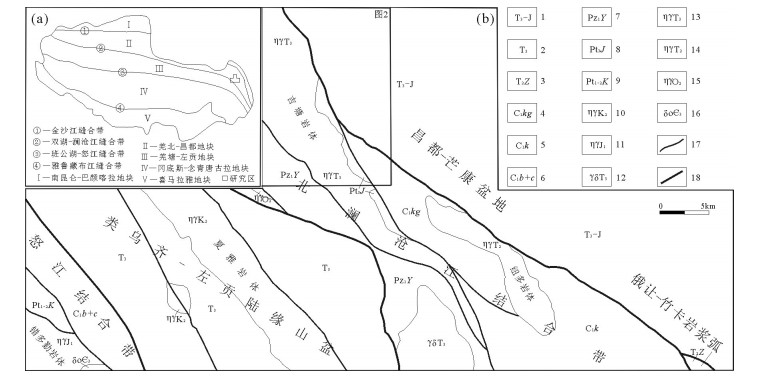
 下载:
下载:
